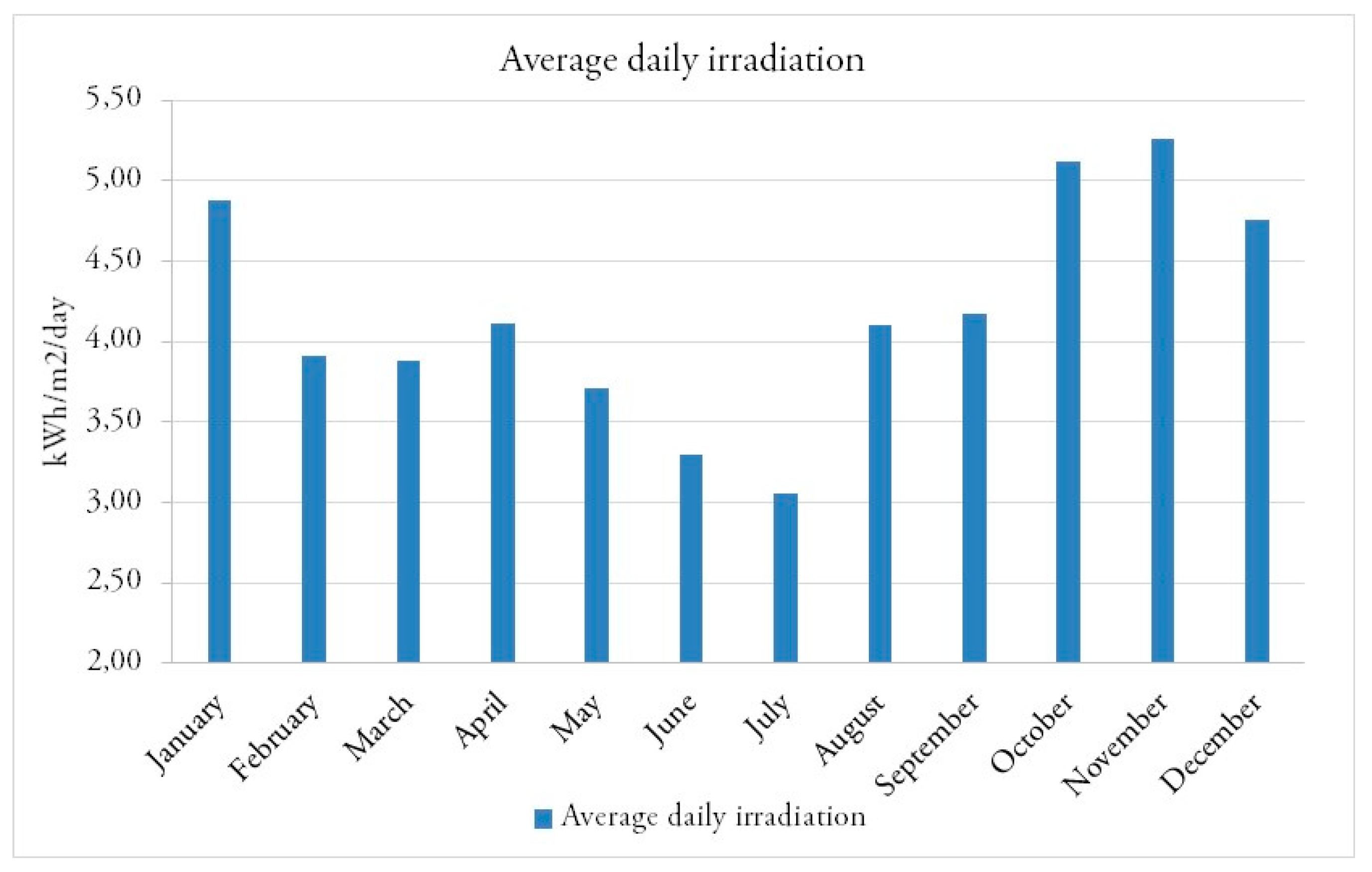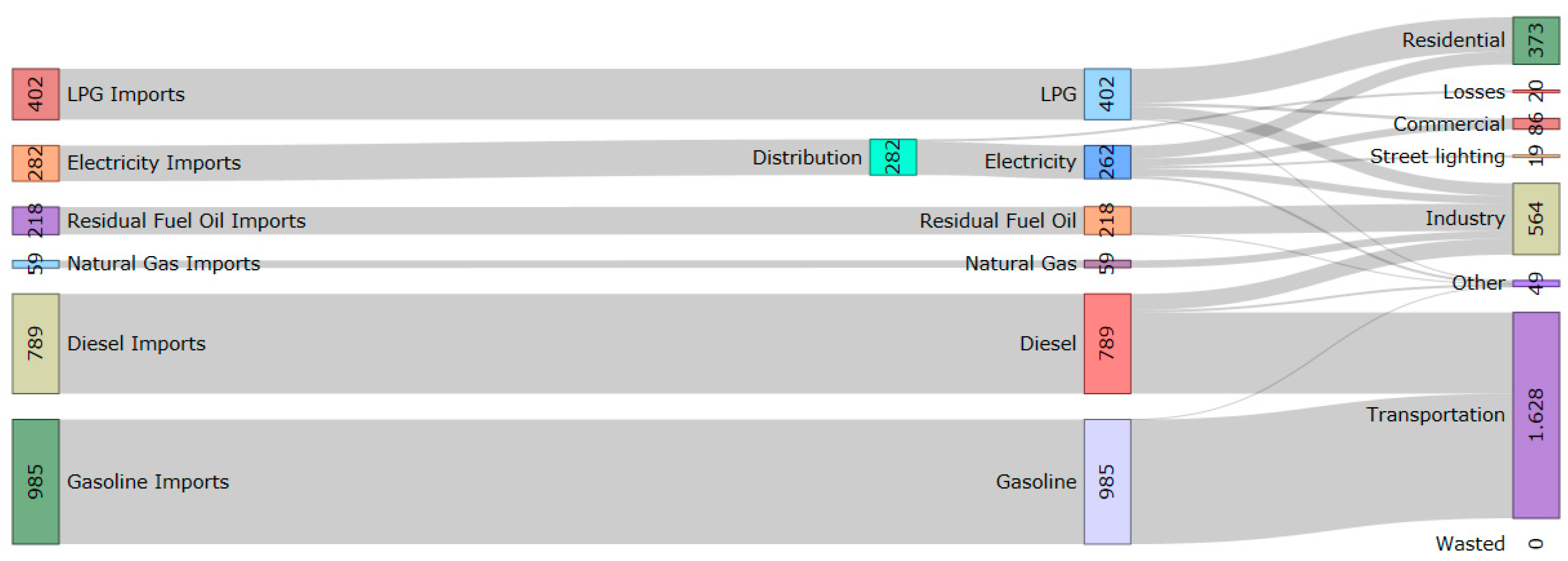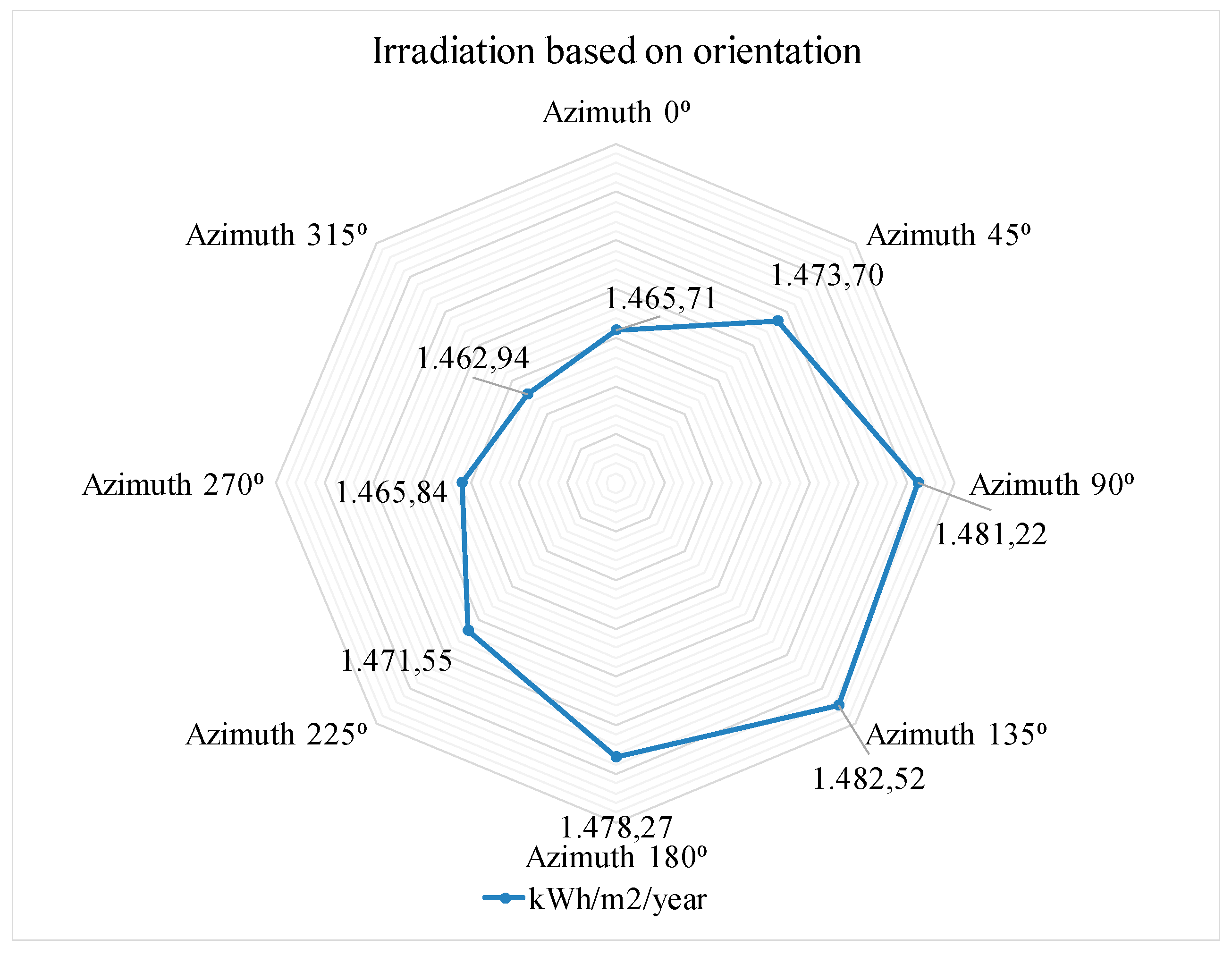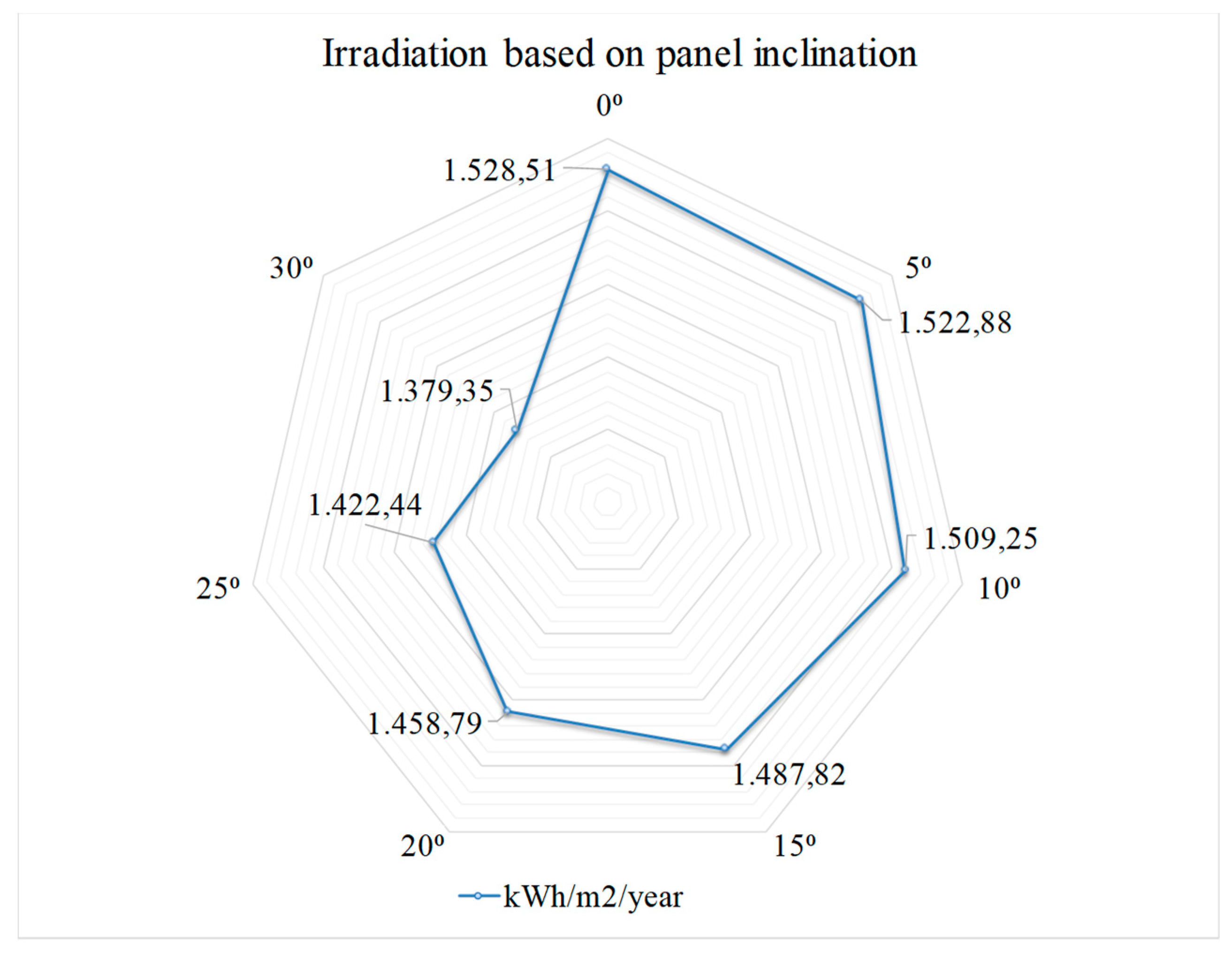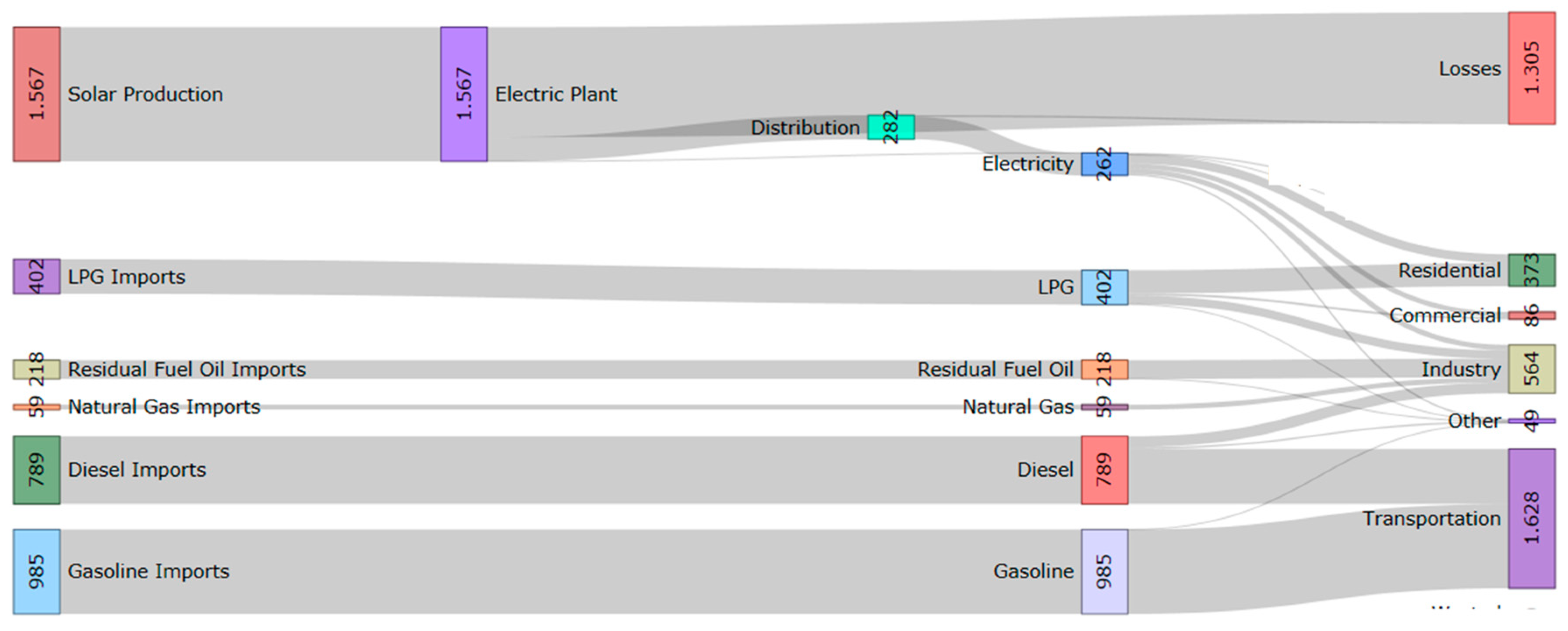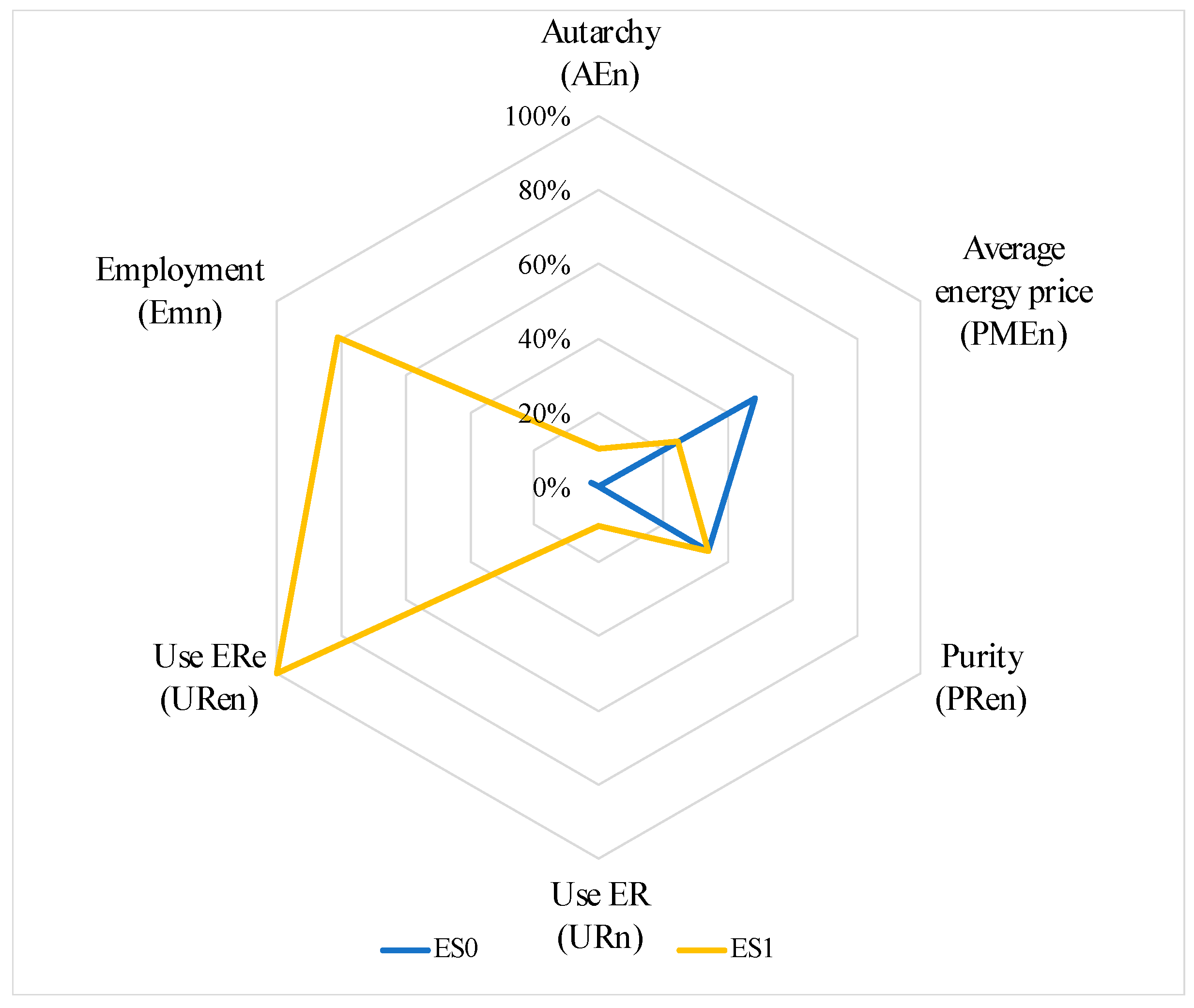1. Introduction
Currently, cities are responsible for 75% of the total carbon dioxide emissions, which are the primary cause of global warming [
1]. The energy demand of urban environments can be reduced or substantially met through the application of energy-efficient measures and renewable technologies [
2,
3]. Furthermore, since these measures can achieve energy independence and democratization for countries in terms of their import needs, the aggressive use of renewable energies (REs) can reduce emissions, create jobs and increase the gross domestic product [
4]. Different possibilities for urban energy self-generation have been analyzed [
5].
In recent years, the urban insertion of renewable energy production has resulted from the adoption of public policies, municipal incentives and the adoption of strategies at different scales and met relative success depending on local conditions [
3,
6]. Photovoltaics (PVs) present the greatest economic, social and environmental development opportunity and are considered the fastest growing technology [
7]. Mainly large-scale solar farms have been developed, which occupy large plots of land and potentially impinge upon nature and food production [
8,
9].
Compared with distributed solar thermal (ST), PV electric power surpluses are more readily exported, which is primarily because heat storage from ST is complex, and considerable waste is produced when it is not used immediately. Wind technology for urban integration is not yet adaptable; urban development interferes with wind technology effectiveness through air current barriers. Moreover, wind technology, which includes moving parts and produces vibrations, is aesthetically questionable, acoustically contaminating, and visually distracting [
10]. Geothermal energy requires a large ground area and is difficult to apply in populated spaces. Other urban technologies take advantage of waste and reduce the need for landfills; however, their conversion to useful energy may not be efficient and could cause environmental issues, such as greenhouse gas emissions [
11].
Resources available in cities can be used to produce energy, however, the global impact of urban insertion has not been properly assessed. Therefore, employing sustainability indicators is important for evaluating the impact of the substantial insertion of PV systems into a city from an integrated energy perspective.
1.1. Photovoltaic Potential in Cities
Several methodologies have been developed to estimate the available and usable irradiation in urban areas [
12]; moreover, multiple strategies have been developed to evaluate the ability of PVs to operate in a built environment [
13,
14]. Three-dimensional (3D) analyses have evolved to a state where they can be used to evaluate urban solar potential. Using 3D analysis methods, the effects of shadows and the surface layout of facades and roofs can be included [
15,
16], along with the urban density and surface orientation [
17]. However, extensive human and computational resources are required to process geometrical information [
16]. These methodologies require substantial resources for redrawing, including two-dimensional (2D) and 3D building surveys, aerial data processing and data discrimination, which are costly. The ground floor building occupancy of many municipalities is stored as vector data in databases and used as a tool for urban planning.
The energy that PVs can provide is closely related to the space available for their placement. Their orientation and potential shadowing are factors that can impact their effectiveness, and the location is relevant because buildings near the equatorial line receive irradiation on almost all roof surfaces. Additionally, at high latitudes, the irradiation on facades is more important.
The International Energy Agency (IEA) predicts that by 2050, PV installations integrated into buildings could supply 32% of urban consumption and 17% of the total power demand (IEA, 2014). In New York, PVs have the potential to generate economic benefits by avoiding distribution and transmission losses (Byrne, Taminiau, Kim, Seo, & Lee, 2015); moreover, they provide additional benefits related to the environment and health.
However, in the analyzed cases of large-scale urban PV deployment, the impact of PVs on total demand (not only electrical) was not determined.
Table 1 lists the research assessing the urban PV potential. Although the methodologies and objectives in the studies varied, they showed that up to 100% of the demand can be supplied; however, achieving that potential energy supply depends on the consumption, endogenous resources and network conditions.
As noted, many studies worldwide have calculated the PV potential using techniques that are often applicable under local conditions (climate, urban topology, latitude, energy demand, the shape of the building) [
27]. PV technology incorporated in urban areas contrasts with different building design aspects that prevent optimal solar availability. The PV potential is closely linked to the space available for the placement of PV panels. The orientation, slope and presence of shadows are other factors influencing the optimal capture of solar energy. Buildings near the equatorial line have the majority of the uptake on roofs; by contrast, in Mediterranean areas up to high latitudes, the facades are more propitious. Several characteristics of a city’s physical location can be exploited to generate more suitable estimates for a specific location. Compared with recent studies, our proposal suggests that solar potential and the incidence of such energy systems should also be measured with sustainability indicators, which are generally applied at the regional or national level.
1.2. Sustainability Energy Indicators in Cities
The incorporation of PVs in a city is evaluated via indicators that allow us to compare the presence and status of public building policies aimed at promoting urban REs. The indicators are formulated according to the measurement requirements. The extrapolation of indicators used at the national and regional scales to urban areas is proposed because indicators that measure urban RE performance have not been defined [
28,
29,
30].
The indicators applied in this study evaluate sustainability by modifying the energy matrix. The Organization for Economic Cooperation and Development (OECD) and the IEA [
31] describe 30 indicators that can be used to analyze the energy situation in a country. Within this base, the Economic Commission for Latin America and the Caribbean (ECLAC), the Latin American Energy Organization (Organización Latinoamericana de Energía, OLADE) and the German Organization for Technical Cooperation (GTZ) [
32] identified 8 sustainability indicators for Latin America.
Another study identified 29 indicators for the energy sector, including energy, social, economic and environmental factors [
33].
The indicators applied to a given situation should be formulated based on the available information [
31]. Indicators that use variables without synergy with other variables are preferred, i.e., indicators whose variables remain constant under variations in other variables.
In the literature, indicators capable of evaluating the variations in an urban energy model using REs were not detected. However, various reports have proposed indicators that measure the energy structure in countries that could be extrapolated. In
Table 2, the indicators that measure proposed sustainability in cities are shown along with citations.
1.3. Case Study
Cuenca city is located in the Andes mountain range near the equatorial line. The city is located between the geographical coordinates of 2°30′ and 3°10′ south latitude and 78°51′ and 79°40′ west longitude and at an average elevation of 2600 masl [
34] (
Figure 1). Approximately 2.28% (73 km
2) of its area (3190 km
2) is considered urban according to municipal legislation.
1.4. Irradiation Availability
The irradiation in Cuenca averages 4.19 kWh/m
2/day on a horizontal surface [
37] (
Figure 2). According to the scale proposed by Koo et al. [
27], the city of Cuenca provides suitable solar resources for PV use. The maximum values occur in January, October, November and December. A reduction occurs between June and July since the region is located slightly south of the equator, and the reduction mostly arises from variations in cloudiness.
1.5. Electrical Demand
The South-Central Regional Electric Company provides urban services to the city [
38]. The combination of electricity sources in Ecuador includes hydroelectric power (49%) and thermoelectric power (47%), with small amounts of wind, PV and biomass energy [
39].
In 2015, the required electric service was 423.80 GWh (262.38 kBOE). The per capita consumption was approximately 3.89 GJ/inhabitant/year (1082.11 kWh/inhabitant/year) [
38]. The residential sector was the largest consumer at 39%, followed by the industrial (23.59%) and commercial (22.72%) sectors.
The total energy demand from different sources is shown in
Table 3. Consumption is strongly influenced by transportation, which accounts for 60%, followed by industry, housing and commerce at 20.76%, 13.72% and 3.15%, respectively. The primary sources are fossil fuel gasoline (GA) at 36.25%, diesel (DI) at 29.05%, liquefied petroleum gas (LPG) at 14.81%, oil fuel (OF) at 8.04% and natural gas (NG) at 2.19%, whereas electricity contributes approximately 9%. Although no precedents have been presented for an actual urban energy mix in Ecuador, the energy situation of the city of Cuenca is presented in
Table 3 and proportionally is very close to the national consumption mix. [
40].
In
Figure 3, the information presented in
Table 3 is shown in a Sankey diagram of the baseline situation in the city of Cuenca. Based on the model proposed by Barragán and Terrados [
41],
Figure 4 indicates the current urban model.
4. Discussion
Compared with centralized REs (solar farms or wind farms occupying 45 km
2/GWh and 72 km
2/GWh, respectively) [
87], renewable energy in cities reduces human intervention and pollution outside the city limits. Given the irregularity of some renewable resources, mismatched consumption-production strategies should be implemented and the storage capacity must be improved [
88]. Large-scale RE within cities is a recent type of application. Consequently, it is necessary to identify its impacts prior to proposing policies for RE use. The goal of this research is to analyze the impact of a massive implementation of PVs in an urban area. The results show that even when the potential for RE can meet the demand for electricity, its influence on the urban energy matrix is marginal. The methodology used to estimate the potential provides a rapid evaluation of the approximate size of the urban PV potential using municipal data for cities with limited resources, such as those in developing countries. This methodology is better suited for an equatorial location, where the totality of the sloped roofs can be used considering that a sloped roof oriented to any direction irradiates evenly.
The calculated potential indicates that the availability of solar energy for the purpose of electricity production is close to three times higher than the demand for electricity. The studies mentioned in
Table 1 presented positive results because of the seasonality, solar radiation and low building consumption for environmental conditioning. These results are comparable to the results of a more detailed study that used 3D roofing models and obtained the precise production demands at daily and monthly scales. However, the previous study corresponds to the commercial sector of the city, and it obtained a PV potential close to 150% of the demand [
42]. In an industrial area with high consumption, the value decreases to 22% [
89].
In Cuenca, solar resources stand out because of the absence of seasonal variations and the comparatively stable energy demand throughout the year, which reduces the required storage. Another feature is the minimal reduction in performance from the inclination and orientation of the PVs, and furthermore, the dispersed growth of the city increases the potential compared to more compact cities. Based on the total estimated area, approximately 42.25 m
2 of roof area is available per inhabitant, whereas in Spain, this same proportion is only 13 m
2 [
27], and this difference is primarily because single-family homes are more popular in Cuenca
. The estimated potential shows that the entire electricity demand can be met with PVs. However, a smart grid and some network adaptations are required to control the intermittencies of production and consumption [
79]. Moreover, solar power represents a good complement to hydropower, which is the main source of the Ecuadorian electricity supply.
In most cities, the use and destination of the energy for consumption are unknown [
90]. Although the energy requirements of cities are not fully known, the impact cannot be established by applying policies that propose a change in the urban energy model [
3].
As has been done at the country level, it is necessary to determine the real impact of adding renewables into the urban energy mix. Most studies review the incidence of PV electricity production, but this research shows that a holistic analysis is essential to establish its real impact. The novelty of this study is that it proposes and measures the impact of electricity self-production using sustainability indicators.
Several international proposals promote renewables adoption in cities [
2,
5]. Despite this interest, methods for measuring the change in the urban energy model have not been established [
3,
91]. There are several urban indicators, including those that measure the management and use of energy, but few are directed to comprehensively evaluate the use of renewables within cities. Therefore, sustainable energy indicators that are usually used at the country or regional level and that are compatible with the proposal of this research were identified.
It is unlikely that a city will achieve total energy self-sufficiency by using only endogenous resources, at least in the short term. Although the importation of energy based on fossil resources does not diminish substantially, the average prices of energy are not substantially altered and may even increase markedly. This is evidenced by a reduction in the PMEn indicator.
The use of renewable energy will still require the import of energy, but it could replace 100% of the electricity requirement. This ability, however, does not alter the energy purity because the urban matrix is highly influenced by transport and fossil fuels. Despite this, the indicator that measures employment with the intensive use of PV solar energy is favoured. The urban energy matrix traditionally maximizes energy use based on fossil fuels. In the case of Cuenca, with the evaluated technology, this energy model has not been modified. Therefore, aside from renewable energies, there are other inescapable strategies that must be embraced (energy efficiency programs, passive strategies, or changes to consumer equipment, especially to electric transport). However, any proposal that seeks to change the way the city is projected must involve authorities, planners or citizens.
In Ecuador, the real price for the production and distribution of electricity is Pe = USD 0.09, and it is reduced to USD 0.04 after public subsidy. This price does not consider the cost of hydroelectric dams, whose construction has been subsidized by public investment. Because the costs of hydroelectric energy are highly subsidized and the production of photovoltaic energy must currently consider taxes on imported equipment, the latter becomes noncompetitive [
79]. Compared to the estimated price, the PV cost is USD 0.12 per kWh, meaning that this source would not be feasible. For this reason, investments and energy costs are decisive factors [
92]. However, considering future electricity growth, PV becomes more attractive because of the rapid price reduction. The use of PV systems also avoids the impact on natural resources; therefore, the subsidies previously applied to hydroelectric energy could be transferred to PVs or other energy alternatives.
5. Conclusions
The estimated potential, determined using information from the study area, requires a deeper analysis that includes technical, environmental, and economic aspects, which could be limiting factors to the extensive implementation of each technology. However, the results are an appropriate starting point. Reduction factors in the area of application represent the primary drawbacks that could affect the calculation of the PV potential using the proposed methodology. However, a deeper analysis is beyond the scope of this research because of the diverse roof characteristics, directionality, inclination, shadows, obstacles and city size, which must all be considered in areas where solar capture is possible. Nevertheless, the information used to obtain the indicators is useful for measuring the impact of PVs on the energy requirements of the city.
In Cuenca, PV technology would be more prevalent if there was a reduction in incoming energy flows, and the autarchy indicator could reach AEn = 10.28%. This result would impact the average price of electricity compared with the baseline scenario (PMEn = 48.27%) since the price increased with PV solar energy when the indicator value was reduced to 23.96%. As previously mentioned, substitution does not affect urban emission limits, since the use of fossil fuels is minimally altered. Furthermore, PV technology would increase EMn, which measures the employment rate (over 78% with respect to the baseline case). The indicator that measures the incidence of renewables (URn) in the energy matrix indicates that even with the massive provision of electricity via PVs (URen = 100%), the city would continue to depend on external resources for approximately 90% of its needs. Achieving the maximum self-sufficiency requires a change in transport systems from fuel to electrical transport systems and the maximization of electrical equipment in buildings.
The indicators used here have been applied to countries rather than cities since cities have not traditionally been considered a source of energy. However, due to current technology, the urban energy model can be changed based on the use of resources available to a city. The proposed indicators are useful at an urban scale because they can be used to assess the real impact of policies designed to decarbonize cities.
The main contribution of this study is a method for evaluating PV solar potential that does not require significant human or computational resources. However, this method may not be as useful or as accurate for other regions where the orientation and inclination of panels are more critical. Based on urban sustainability indicators, this study also evaluates the impact of electric power provision on the entire energy system. The results show that substituting electricity with renewable sources will not solve the urban energy problem. A complete and detailed evaluation is required to encourage the use of other REs in applications such as transportation and heating, and to promote the use of equipment that consumes electricity or nonfossil fuels.

